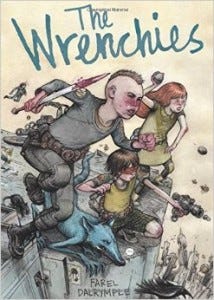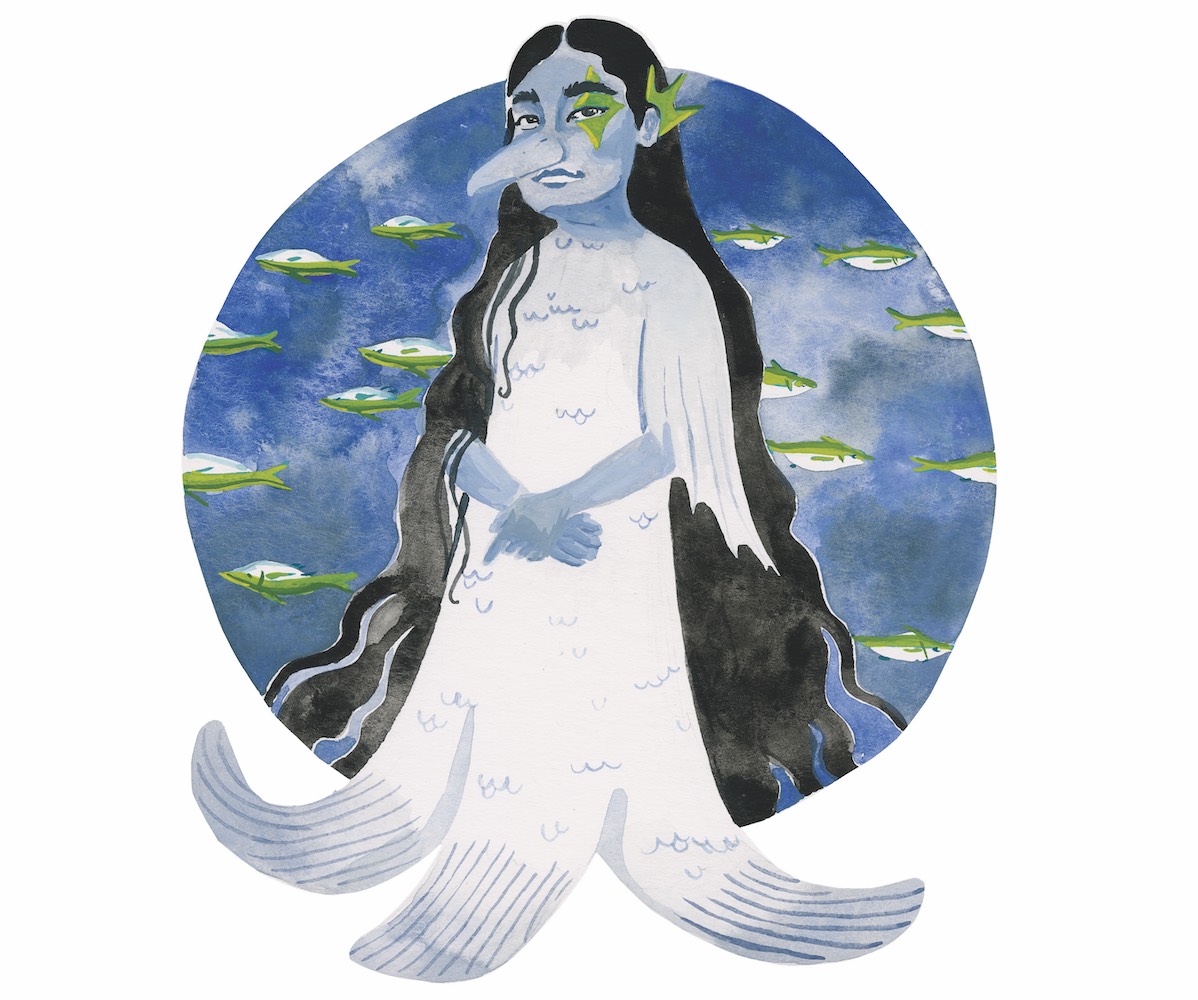interviews
INTERVIEW: Farel Dalrymple, author and artist of The Wrenchies


The first work of writer/artist Farel Dalrymple’s that I read was Pop Gun War, a magic realist graphic novel about a young boy with wings traversing a surreal city. Its storyline encompassed philosophical explorations, touring punk bands, and sinister dollmakers; it read like nothing I’d encountered before, and Dalrymple’s art seemed equally suited to the story’s fantastical and gritty elements. Dalrymple’s latest work as writer/artist is The Wrenchies, which takes the juxtapositions of Pop Gun War to an entirely different level.
The story begins with Orson and Sherwood, two brothers who encounter a sinister, vampiric being in a cave and embark on a career of monster-slaying. Their story, along the story of Hollis, a superhero-obsessed kid in the present day who occasionally encounters a ghost, and a group of children fighting demons in a distant future (those would be The Wrenchies of the title) all come together in a plot that’s both epic and idiosyncratic.
I caught up with Dalrymple via phone to discuss the origin of The Wrenchies, how the story developed, and some of his other projects.
I remember reading the short story that appeared in Meathaus that feels like an early version of The Wrenchies. Did you realize when you were writing that that it would lead to something much larger?
I don’t know if I knew when I was working on it, necessarily. But after I finished it, it was basically, “Yeah, I’m going to do something more with this.” I met an agent; I moved to Portland around the time that it was coming out, and she asked me if I was working on anything. She asked me if I was working on anything, and I said that I had this thing that had been in an anthology that I wanted to expand upon. It was a year or two before I actually started working on it.
What was the first point, from there, that you expanded on? Was it a continuation of that story, or showing a completely different dimension to the world?
Maybe adding the character of Hollis to the story? I’m not actually sure when exactly that got added. There were so many things that went into that–when I read the anthology, there was another story in there by this guy Tom Herpich, this really awesome cartoonist who works on Adventure Time and stuff now. He does his own comics, that are really great; I really liked his story. I was watching a lot of weird movies at the time, and I wanted to do all of these different things. I thought, “Oh, there’s this idea I have with these kids, and with this guy kind of seeing his future,” and all of this stuff that I wanted to put together in a hopefully interesting way. I don’t remember exactly what the one thing was; it just all kind of came together when I was constructing this idea for doing this graphic novel.
There are so many different layers and timeframes and worlds in the story; did you organize all of that beforehand?
I had to do a lot of organizing. Making timelines; at some point during the whole process, I had a whole bunch of notes pinned to a wall, and a sequence of pages that I was doing. I knew how the chapters were going to begin and end, and I knew how the book was going to end, but getting there sometimes required some problem-solving. Laying things out in a visual way so that I could figure out how to make it all work together, at least for me. I know that a lot of people probably won’t get all of the stuff going on, but I wanted to make sure that I really understood what was happening.
At some points, the narrative unfolds along the lines that a reader might expect; at others, characters might have horrible things happen to them offscreen, or major events will happen in passing. How did you decide which things would happen on- or off-panel?
That was a case-by-case basis. A lot of that was also me wanting to draw something I thought was cool. “Oh, I’m going to draw these gory bug-things coming out of this guy’s neck.” Other times, it depends on what I’m trying to do. If I’m trying to evoke a certain emotion or make someone think about something–not that I’m trying to be manipulative or anything, but if there’s a scene where I want a certain emotion to come across, I try to do that in different subtle ways. As un-subtle as a lot of that book is, I feel like there are a lot of parts in there where I’m trying to say something, and I don’t just want it to be about this one thing. I’d like it to provoke some thought and challenge some people. Some of the things that I’ve liked reading, growing up or as an adult, is stuff where it makes me think about it a lot. That’s what I enjoy. Sometimes, I just want to shut off and enjoy a ride. I guess that’s why I chose to do that in different manners or styles–having narration in some places, and in others, not even acknowledging what happened there. This could have taken place in a few years, or it could have been a few days.
Are there comics or books or movies that have inspired the same kind of emotions that you wanted to evoke with this?
There’s tons of stuff that I put in there; I even did an homage page to the television show The Prisoner. That was a big deal to me growing up. It’s weird, having all of this stuff that I liked as a kid in pop culture so much. A lot of people know about The Prisoner and The Warriors and Doctor Who and all that stuff that to me, as a little kid, was this weird and mysterious thing. It’s this faded memory. At some point, I got the DVDs when they came out; now, it’s just another thing for people to be nerdy about. Things like that show, and this movie that I mention a lot in regards to this book called Over the Edge. It’s a 1979 movie about these kids who riot at a school. I liked the way that these kids were…little kids, but they have crazy parties where they’re drunk and doing drugs and all sorts of stuff. They had this weird mix of little-kid fun and sounding like adults when they talked with one another.
The book The Chocolate War was a big deal to me growing up. The movie, too. I liked that movie a lot. There’s a bunch of comic books, too. I grew up reading Marvel Comics. John Buscema, stylistically; I feel like a lot of my storytelling comes from How to Draw Comics the Marvel Way. As far as the feeling I like to put in my work, I feel like it comes more from weird movies and young adult books and things like that.
The Wrenchies opens with Sherwood’s story, but it also shows how he’sless and less of a hero at various points in his life–he’s the hero of one story and the villain of another one, in some ways.
Sometimes, I get worried that people are going to read too much into something. There’s a lot of stuff that I put in that I feel like other writers and cartoonists have probably done better than me. That thing of a little kid, who says, “I can do anything I want to do! I can be a rock star, a movie star, a superhero.” It’s this kid who actually does all of that stuff, but as little kid he also sees himself having done all of this stuff, and he’s this loser, still. “Oh, I’m an asshole as an adult.” And he also has some weird stuff, my own anxiety that I used to have as a little kid about growing up and being the Antichrist.
I was raised really religious; I would think, “Oh no–what if that’s me?” It was this really weird, irrational fear. It’s not enough to have all the real fears in life as a little kid; let’s make up some weird thing for you to stress out about. I wanted him to be this superhero–a real superhero–and then a secret agent, but he’s also this human being, a tragic figure.
I was going to ask about that–Sherwood makes references to religion at a few places, and Hollis does as well. Did that come from the way that you were raised?
Oh yeah, totally. I was, like a lot of people, an evangelical-style Christian. It seemed like moving out of that as a grown man–I was in my twenties, my early twenties–and then going to school in New York… I’d been around the real world before, I’d had friends who weren’t Christians. It put everything in perspective. New York’s a weird place anyway; it made me realize that I was raised really strangely. Over the next few years–it’s kind of a cliche–I really thought about why I believed things that I believed. I love my mom, and she did the best she could, but it was kind of a strange upbringing, I feel like. It’s good material, a source of material for stories about little kids who like comic books and stuff like that.
Both in The Wrenchies and in Pop Gun War, you have these very sinister monks who show up at various points in the story. Was that also a nod to that, or more something for the visual?
That’s partly because I like the way it looks. One of the things that made me want to tell my own stories was reading The Brothers Karamazov. There’s this crazy monk character in there; I think he’s just in one scene in the beginning, where they talk about him. I remember being kind of excited about that; I don’t know why. I put him in Pop Gun War; he seemed like a good, weird villain. He doesn’t do anything terribly sinister; he just seems sort of scary. I remember, when I was living in New York, I would see weird scary dudes. It seemed fitting to have this weird… He doesn’t represent religion or anything like that. It’s more that he’s a tortured guy who does crappy things to people sometimes. This obnoxious person you don’t like.
You’ve done some work where you’re the artist working with another writer–most recently, Prophet. Does working on something with a writer have any effect on your own storytelling?
I’ve done it mostly because it’s a paying job, and it’s generally fun. Prophet has had its fun moments, and I love being a part of that group of artists. It’s exciting to do something like that. And if I do stuff for Marvel or DC, I’ll do a page or two pages, and it’s always the hardest thing in the world. Doing a commission for someone–”Oh, okay, I’m drawing Dr. Strange”–it takes forever. It’s a weird pressure; I don’t know what it is. Even as a kid, I liked drawing my own guys, my own characters, rather than drawing Spider-Man. I don’t think of it, myself; it just feels like a job. I like the work that I’ve done for other people, generally. I feel like it makes me a better artist: “How am I going to do this, rather than just being totally self-indulgent and drawing whatever I want to draw.”
The Wrenchies was a lot of hard work, for sure. It made me nuts a lot. But there wasn’t ever a feeling like I didn’t want to be working on it. I never felt like that. With every other kind of job where I’m working with a writer, even if it’s a really good story, there’s still that part of me that goes, “Dammit! I don’t want to be doing this right now!”
Do you have a sense of what the next story you want to tell is?
I’m doing two serialized projects. I’m pretty behind on one of them. I’m doing a story with a writer friend of mine–it’s going to be in Dark Horse Presents. I’ve only done eight pages of it so far, so I’ve got to get into high gear on that. I’m also doing a sequel to Pop Gun War, and that’s going to be run in Brandon Graham’s Image anthology called Island. I’m doing that in fifty-page installments. I’ve been working on that lately. That’s what I’ve been doing whenever I have a few hours.
When did you first end up moving in Portland? Does that have any effect on the work that you do, do you think?
I moved here seven, eight years ago. I was just finishing up Omega the Unknown; I did that for about a year after I moved here. I’ve been working on The Wrenchies the whole time, pretty much. But I did some other stuff; I did a young adult story that’s going to be coming out from Secret Acres next year. While I was working on The Wrenchies, I had to do other jobs whenever I could. I did a story with MK Reed, who’s a writer; it’s called Pale Fire, and it’s coming out next year from Secret Acres. I feel like my living in Portland definitely had an effect on how I drew that. It’s a black and white story, but there are a lot of scenes set outside with trees and highways and Volvos icing around town.
Is there a connection to the Nabokov novel?
I think she mentions it in the foreword. She made this as a mini-comic years back. Then, I basically just re-drew her comic. She mentions it in the foreword, that she was inspired to do this story, but it doesn’t really have anything to do with it. It’s mostly teenagers at a party, driving around in cars. Greg Means put that together, had me re-draw it and stuff. He has an imprint in town called Tugboat Press. I wouldn’t have even done that story if I hadn’t moved to town. There are so many artists and publishers in town; I feel like I got a lot of opportunities that I wouldn’t have if I lived somewhere else. Even New York. There’s a comic store here called Floating World Comics, and Jason, the proprietor, he’s put out work of mine. Zack Soto, who does the Study Group Comics website, lives here in town and had me start doing the It Will All Hurt strip that I’ve been doing for that. That wouldn’t have happened without my moving here. So yeah, moving to town has definitely helped shape the last few years of my career.
Earlier, you talked about how The Wrenchies let you put a number of disparate elements into the same story. Was there anything that you’d wanted to fit into there that you realized wouldn’t fit and needed to go into something else?
I have a lot of stuff that ended up on the cutting-room floor. I put them all in a file, and said, “I’m going to do something with this someday.” Some of it’s going to go in a sequel. Other stuff, I don’t know what I’m going to do with it yet. Especially towards the end, the Sherwood chapter–all of the stuff that I left out of there could be another book. Hopefully someday I’ll get to it.









